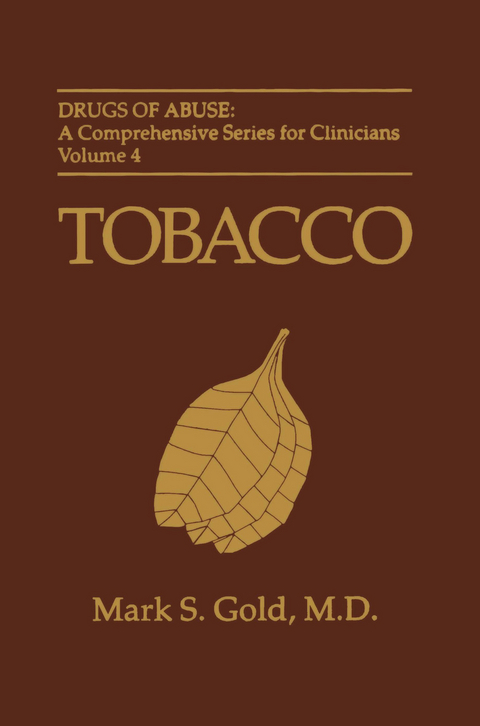
Tobacco
Springer-Verlag New York Inc.
978-1-4613-5748-3 (ISBN)
1. Tobacco in the 1990s.- The Facts about Tobacco.- Smoking in the Workplace.- Smoking and Children.- The Tobacco Lobby versus the Medical Evidence.- Cigarettes—Reality Sinks In.- References.- Additional Sources.- 2. Tobacco: A Short History of the American Economy.- References.- Additional Source.- 3. The Neurobiological Effects of Tobacco.- A Common Neuroanatomy of Reward for Drugs of Abuse.- Reward and Reinforcement.- Reinforcement.- Stimulant Reinforcement.- Reinforcement Leads to Learning.- Nicotine and Withdrawal.- Clinical Implications.- Behavioral Manifestations of Reinforcement.- Nicotine and Its Neurobiological Effects.- Comorbidity and Cholinergic Effects.- Nicotine’s Neurobiological Link to Tolerance and Dependence.- Conclusion.- References.- Additional Sources.- 4. Tobacco and the Body.- The Pharmacology of Cigarettes.- Mortality and Tobacco.- Smoking-Associated Illnesses.- Smoking and the Heart.- Respiratory Effects.- Cancer.- Smoking and Pregnancy.- Smoking, Aging, and Alzheimer’s Disease.- Smoking and Weight.- Metabolism.- Secondhand Smoke.- Reversibility of Effects.- References.- 5. The Psychiatric Aspects of Tobacco Use.- How the Tobacco Industry Lives with Itself.- The Real Truth Behind Tobacco’s Psychiatric Effect.- Comorbidity and Tobacco.- Is There a Biological Link?.- Smoking, Depression, and Alcohol.- Smoking and Other Psychiatric Problems.- Reinforcement and Cues.- Cognitive Effects and Anxiety.- Craving.- Other Effects.- Chronic and Acute Tolerance.- Nicotine Withdrawal: Signs and Symptoms.- Conclusion.- References.- Additional Sources.- 6. Treatment and the Role of the Physician.- The Challenge to the Medical Profession.- Getting a Program Off the Ground.- Diagnosis: The First Step.- Assessing the Practitioner’s Role: Step Two.-Devising the Program: Step Three.- Treatment Options: Step Four.- Recovery.- References.- Additional Sources.- 7. A Model Cessation Program: Basic Guidelines from the National Cancer Institute.- Synopsis for Physicians: How to Help Your Patients Stop Smoking.- Synopsis for Office Staff: How to Develop Office Procedures to Help Patients Stop Smoking.- Step 1: Select an Office Smoking-Cessation Coordinator.- Step 2: Create a Smoke-Free Office.- Step 3: Action Summary.- Step 4: Action Summary.- Step 5: Action Summary.- 8. Smoking and Special Populations.- Children and Adolescents.- The Role of the Health Profession in Preventing Smoking among the Young.- Smoking, Children, and Health Consequences.- Heart Disease.- Cancer.- Smokeless Tobacco.- Addictive Behavior.- Why Young People Smoke: Psychosocial Risk Factors.- Baiting the Hook: Tobacco Advertising and Promotional Activities.- Smoking and Young Women.- Menstruation.- Pregnancy.- Racial Targets: Smoking Differences between Blacks and Whites.- Physicians and Smoking.- References.- 9. Prevention and Education.- Education Is the Best Measure of Prevention.- How to Help Your Patients Stop Smoking: More Ideas from the National Cancer Institute Manual for Physicians.- References.- Additional Source.
| Reihe/Serie | Drugs of Abuse: A Comprehensive Series for Clinicians ; 4 |
|---|---|
| Zusatzinfo | XI, 211 p. |
| Verlagsort | New York, NY |
| Sprache | englisch |
| Maße | 140 x 216 mm |
| Themenwelt | Medizin / Pharmazie ► Medizinische Fachgebiete ► Psychiatrie / Psychotherapie |
| Studium ► Querschnittsbereiche ► Epidemiologie / Med. Biometrie | |
| Studium ► Querschnittsbereiche ► Prävention / Gesundheitsförderung | |
| ISBN-10 | 1-4613-5748-9 / 1461357489 |
| ISBN-13 | 978-1-4613-5748-3 / 9781461357483 |
| Zustand | Neuware |
| Haben Sie eine Frage zum Produkt? |
aus dem Bereich


